Why Do We Have So Many Polkas and Waltzes?
 I have done a bit of research on the polka in “ethnic” America, and this really is a pressing question. At least in some circles (ahem). Some bands, if they play this sort of music, really do play only polkas and waltzes. My answer was that the polka’s dance movements are relatively simple, can be fitted to almost any duple-meter music, and are hardly distinctive (apart from the hop that is often omitted anyway). Not everyone agrees with this assessment, but it’s not a new idea.
I have done a bit of research on the polka in “ethnic” America, and this really is a pressing question. At least in some circles (ahem). Some bands, if they play this sort of music, really do play only polkas and waltzes. My answer was that the polka’s dance movements are relatively simple, can be fitted to almost any duple-meter music, and are hardly distinctive (apart from the hop that is often omitted anyway). Not everyone agrees with this assessment, but it’s not a new idea.Moravian/Czech composer Leoš Janáček asked and gave his answer to this question in a column. He wrote, in Lidové noviny of 9 April 1905:
Every dance has its choreographic idea to which the musical idea fits. Twirling in a circle in time-units of four or three beats is the smallest and purest of these ideas: even children are polkaing and waltzing. We can dance thus to any sort of music. The simpler the choreographic idea, the richer the corresponding musical repertory. We find in it the names of the celebrated composers. It is different for the complicated choreographic ideas of Moravian folk dances. For the movements of such complicated ideas we remember a specific melody. People dance the pilkas and čeladenský only when they hear the melody that they know; musicians can only give some variations on this melody. This explains the style of folk dances it is necessary for us to save. Only a ballet troupe with its training would be able to present pilkas and čeladenský with new music or that of another composer; [dancers are the scab workers of the world]. Therefore we have about 300 types of folk dance in Moravia among which the polka and waltz were not particular folk dances: but their choreographic ideas (twirling) were only a few among the many motives of the rich dance choreographies. Now it is different: they are dancing hardly more than two dances, the polka and waltz, and the music to them is—for shame.
(This rough translation from the reprinted article in the 1955 edition of Janáček’s writings, O lidové písně [On folksong], ed. Jiří Vysloužil, p. 229)
Do keep in mind that it was Janáček’s program to distinguish what was Moravian about the music and dance he was studying. He was a staunch nationalist and pan-Slavist in many aspects of his life, so there is more than meets the eye to this article.
What Janáček doesn't mention, though, is "polka happiness." That is the key to any serious study of the polka. Seriously! It was theorized by Charles Keil and examined most thoroughly in his book, coauthored with Angeliki V. Keil and Dick Blau, Polka Happiness (Temple Univ. Press, 1992). It's a good read.
Photo from the Illustrated London News, 1844.
 A graduate student in music and anthropology writing a dissertation about music in Moravia, the eastern third of the Czech Republic. At some point, the Czech Republic's "second city" (that would be Brno) captured my attention, and I've since been blogging about events, arts, music, and other stuff—basically whatever interests me in and around the cityscape. I'm not living in Brno now, but I keep up with the cultural pulse from afar as best I can.
A graduate student in music and anthropology writing a dissertation about music in Moravia, the eastern third of the Czech Republic. At some point, the Czech Republic's "second city" (that would be Brno) captured my attention, and I've since been blogging about events, arts, music, and other stuff—basically whatever interests me in and around the cityscape. I'm not living in Brno now, but I keep up with the cultural pulse from afar as best I can.


Comments:
» Post a Comment